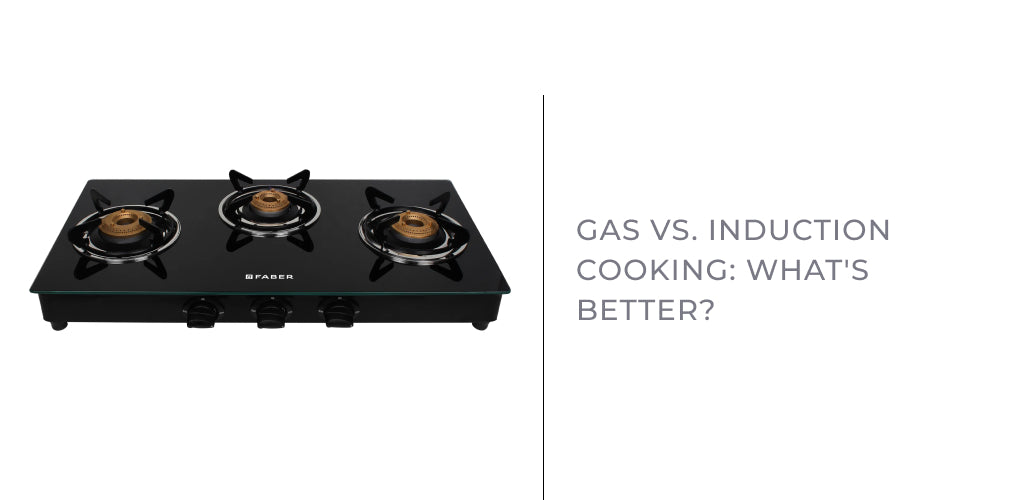Gas vs. Induction Cooking: What's Better?

Gas cooking and induction cooking are two common technologies used in kitchens all around the world. Gas cooking uses burners to heat cookware with an open flame, whereas induction cooking heats cookware directly with electromagnetic fields. Both methods have their own benefits and considerations.
Understanding the differences between gas and induction cooking will help you make an informed decision about which method is best for your cooking requirements and tastes.
Introduction to Gas Cooking Technology
· Gas cooking technology uses natural gas to produce heat for cooking. When a gas stove is turned on, the burners usually release an open flame.
· The flame heats the bottom of the cookware directly, allowing for rapid temperature changes. Gas stoves are well-known for their versatility, as they can accept a variety of cookware kinds and sizes.
· The heat generated by gas burners is easily adjustable, providing precise control over cooking temperatures.
Advantages of Gas Cooking
1. Instant heat control and responsiveness : Gas burners produce immediate heat, allowing for quick temperature adjustments while cooking.
2. Heat levels : Gas stoves have a wide range of heat settings, from low simmer to high, making them versatile for a variety of cooking styles.
3. Traditional cooking experiences: Many individuals enjoy the appealing appearance and comforting feel of cooking over a gas flame.
4. Power Blackout: Gas cooking appliances can still be used during power outages because they do not require energy to operate.
5. Widely available: Gas cooking is a well-known technology that is extensively used in homes and restaurants, making it simple to find and operate.
Introduction to Induction Technology
· Induction cooking is a modern and efficient process that uses electromagnetic technology. Unlike standard gas stoves, it does not use open flames or hot surfaces.
· Magnetic field that heats only the cookware, allowing for quick and precise temperature control. The cookware itself becomes the heat source, allowing for quicker cooking times and more energy efficiency.
· Induction cooking also provides safety benefits because the cooktop stays cool to the touch.
Advantages of Induction
1. Efficiency: Induction cooking is extremely energy-efficient, converting almost all of the energy to heat.
2. Precision: Temperature control is instant and precise, resulting in accurate cooking outcomes.
3. Safety: The cooktop stays cool, lowering the risk of burns and creating a safer cooking atmosphere.
4. Speed: Rapid heating shortens cooking periods, saving both time and energy.
5. Easy Cleaning: Smooth surfaces are easy to clean because there are no burned-on food residues.
6. Versatility : Compatible with a wide range of cookware materials, providing flexibility in the kitchen.
7. Modern Design: Sleek and modern, boosting the beauty of your kitchen.
Comparison of Gas and Induction
1. Heat Control and Response:
· Gas provides instant heat with responsive control.
· Induction provides precise and quick temperature adjustments.
2. Energy Efficiency and Costs:
· Gas : There may be energy waste and associated expenditures.
· Induction is a highly efficient process that saves energy and lowers power bills.
3. Safety Features:
· Gas : Open flames represent a safety risk.
· Induction: Cool cooktop surfaces and automated shut-off improve safety.
4. Installation and maintenance:
· Gas: Requires gas lines and routine maintenance.
· Induction: Simple installation, easy-to-clean surfaces, and little maintenance.
Comparing these aspects allows you to make an informed selection between gas and induction cooking based on your specific preferences and kitchen needs.
User Experience and Preferences in the Kitchen
1. Cooking Style and Preference:
· Gas appeals to individuals who like conventional cooking methods.
· Induction: Attracts users who value precision and speed when cooking.
2. Kitchen design and practical considerations:
· Gas lines are required, which may limit the arrangement of the kitchen.
· Induction : Sleek designs and flexible placement choices make it ideal for modern kitchens.
Frequently Asked Questions
1. Is induction cooking safe?
Yes, induction cooking is safe as the cooktop remains cool, reducing burn risks.
2. Can I use any cookware with induction stoves?
No, only cookware with magnetic properties, like stainless steel or cast iron, works on induction stoves.
3. Is induction cooking energy-efficient?
Yes, induction cooking is highly efficient, converting almost all energy into heat.
4. How does induction compare to gas in terms of cost?
Induction may have a higher initial cost but often results in long-term energy savings.
5. Does induction cooking require special maintenance?
Induction cooking surfaces are easy to clean, requiring minimal maintenance compared to traditional gas stoves.
Conclusion
In summary, the choice between Faber India’s best gas stove burners and induction cooktops depends on personal preferences and needs. Faber's gas stoves provide a conventional cooking experience with fast heat control, making them suitable for individuals who like old methods. Induction cooktops, on the other hand, offer energy efficiency and technological efficiency.
Consider your cooking style, kitchen design, and environmental impact while making a decision. Whether you like the classic elegance of gas burners or the smooth efficiency of induction, both options provide superb cooking. Explore Faber's options and select the best option for your cooking experience.
 1800-209-3484 (Toll free from 8:00 AM - 8:00 PM)
1800-209-3484 (Toll free from 8:00 AM - 8:00 PM) 





